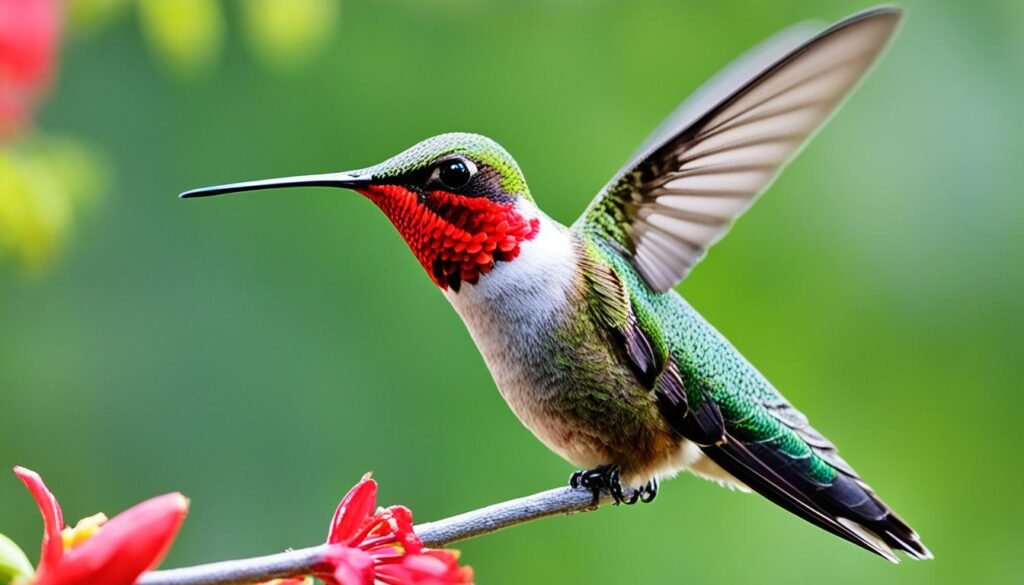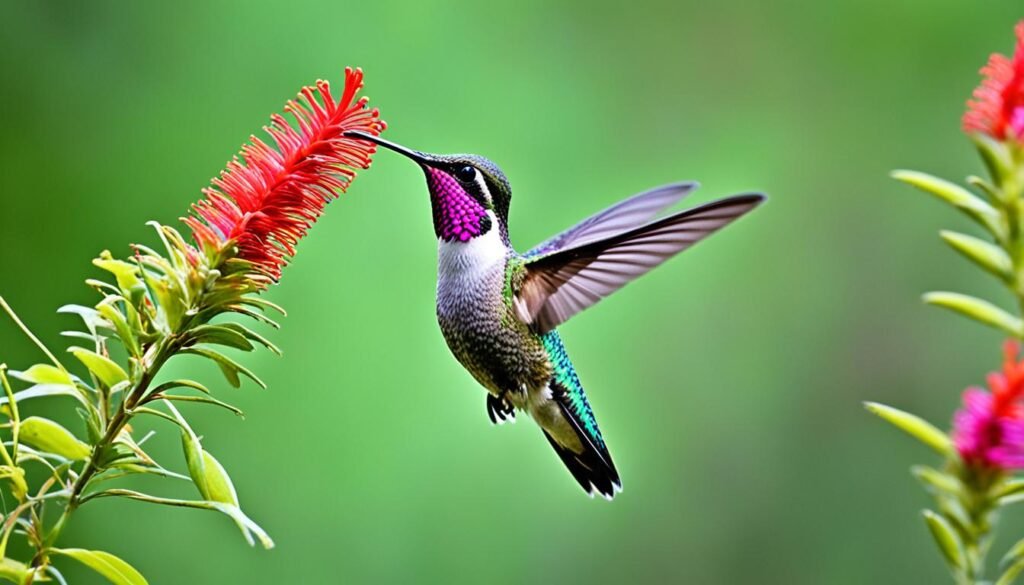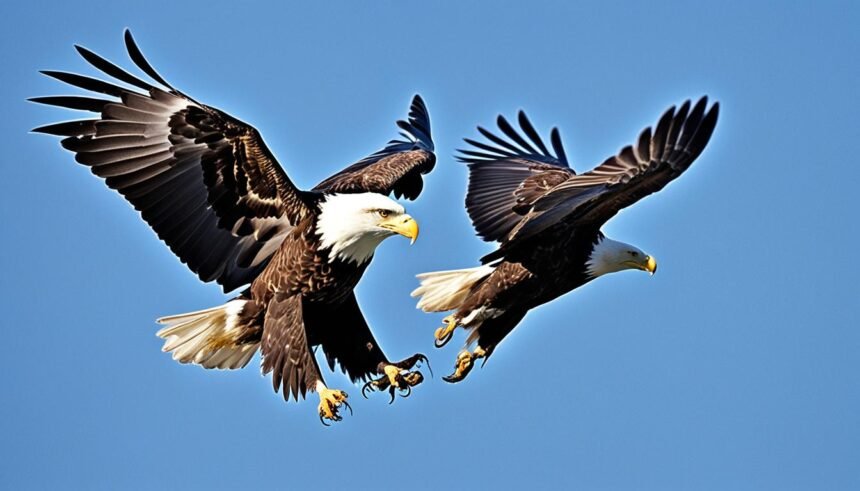
Hummingbirds have a fascinating mating ritual in the spring and early summer. They return from their winter migration to Mexico and Central America. The timing of their mating varies by species and location.
Some, like the Anna’s Hummingbird, start mating in December in the western U.S. Others, like the Ruby-throated Hummingbird, begin in late March to early April in the eastern U.S. and Canada.
After returning to their breeding grounds, hummingbirds mate quickly. Males must first defend their territories. Then, they attract females with their bright colors and amazing courtship displays.
Introduction to Hummingbird Mating
The mating rituals of hummingbirds are fascinating. These small, lively birds have a captivating courtship. It shows off their amazing physical skills. The males’ bright feathers and the aerial tricks they perform are a sight to see.
Fascinating Facts About Hummingbird Mating
Male hummingbirds show off their bright colors and amazing moves to get a mate. The Anna’s Hummingbird can dive at speeds over 385 times its own length in a second. This speed, along with special sounds from their wings, is part of their courtship.
It’s the female hummingbirds who pick their mates. Males fight hard to protect their territory. They fly fast and use their sharp beaks to defend it. The Ruby-throated Hummingbird makes unique sounds and wing noises that help in mating.
Even though they’re tiny, hummingbirds have a lot of energy and skill during mating. Their amazing abilities show how well they’ve adapted to their world.
Hummingbirds’ mating behaviors are a fascinating display of nature’s creativity. They show off their incredible skills. From the males’ bright feathers to their aerial stunts, their courtship is a wonder to see.
When Do Hummingbirds Mate?

Hummingbirds plan their mating and breeding to match their return from migration and the food availability. In the eastern U.S. and Canada, Ruby-throated Hummingbirds start mating in early spring. Males arrive in late March, and females come 7-10 days later.
In the western U.S., species like the Anna’s Hummingbird may mate from December to March/April. The exact timing varies by species, location, and weather. It also depends on if there’s enough food for breeding and raising young. Hummingbirds usually mate soon after they return to their territories.
Some key facts about hummingbird mating and breeding seasons:
- Ruby-throated Hummingbirds have a range mass of 3.4 to 3.8 grams and a length of 7.5 to 9.0 cm.
- Ruby-throated Hummingbirds can raise up to three broods each year, with their peak breeding season being mid-May.
- Female hummingbirds take less than a week to build their nests before mating.
- Hummingbirds have a varied breeding season depending on their location, with some starting in spring while others can begin as early as November.
The timing of hummingbird mating depends on the species, location, and the environment. These factors support their breeding and nesting. Knowing this helps us support hummingbird conservation.
Male Hummingbird Courtship Displays
During mating season, male hummingbirds show off with amazing courtship displays. The top show is the dive display. A male goes up to 150 feet high and then drops straight down fast. He pulls up just in time, reaching speeds over 385 body lengths per second.
This stunt, seen in birds like the Anna’s Hummingbird, feels like 9 times the force of gravity. It’s a thrilling way to catch a female’s eye.
Colorful Plumage and Dazzling Flights
But it’s not just the dive that gets the job done. Male hummingbirds also flash their bright, shiny feathers. Birds like the Ruby-throated and Allen’s Hummingbirds show off their colorful throats and tails during courtship.
They make loud sounds with their wings and voices to draw in females. It’s a colorful and noisy way to show off their territory.
Female Hummingbird Nest Building

During hummingbird mating, the female builds the nest alone. This takes about a week. She gathers and weaves natural materials to make a small, cup-shaped home.
Spider silk is key for the nest’s strength and stability. The female adds twigs, leaves, moss, and lichen for camouflage. This makes the nest blend in with its surroundings.
Hummingbird nests are tiny, just about 4 cm (1.6 inches) wide inside. Yet, they show great engineering and skill. The nests are often on thin branches over open areas or streams. This gives them safety and easy access to food.
The nest building shows the female hummingbird’s hard work and talent. She carefully picks and weaves materials. This creates a safe, hidden home for her future babies.
Incubation and Brooding
Caring for Hummingbird Chicks
After the female ruby-throated hummingbird lays 1-2 tiny white eggs, she starts the 14-16 day incubation period. She sits on the nest for about 50-55 minutes each hour. This keeps the eggs warm and safe.
When the chicks hatch, they are very small and can’t do anything on their own. The mother must leave the nest only to get food. She brings back nectar, pollen, and insects to feed the chicks. The male doesn’t help with the chicks.
The baby hummingbirds are tiny, weighing about 0.62 grams and being just an inch long. They can’t see for the first nine days and can’t feed themselves until they grow more. The mother feeds them every 20 minutes with nectar and soft bugs.
After about three weeks, the chicks leave the nest and can find food by themselves. The mother may still feed them for another 4-7 days before they are fully on their own.
| Hummingbird Nesting Facts | Details |
|---|---|
| Incubation Period | 14-16 days |
| Time Spent on Nest per Hour | 50-55 minutes |
| Hatchling Weight | 0.62 grams |
| Hatchling Length | 1 inch |
| Blind Period | 9 days |
| Feeding Frequency | Every 20 minutes |
| Fledging Age | 3 weeks |
| Post-Fledging Care | 4-7 days |
Re-nesting and Double-brooding

Sometimes, hummingbird nests face challenges from nature. Cold, wet weather can harm eggs or young birds. Strong winds might knock the nest down. But, resilient female hummingbirds often try to re-nest and start again.
Early returners and quick mates have a good shot at re-nesting success. Yet, in the northern U.S. and southern Canada, time is short for re-nesting if the first attempt fails.
In the southern U.S. and along the Gulf Coast, the nesting season is longer. Here, females might raise a second brood in the same season. In Florida, some species can even have three broods in one season.
| Region | Re-nesting Feasibility | Double-brooding Feasibility |
|---|---|---|
| Northern U.S. and Southern Canada | Lower | Lower |
| Southern U.S. and Gulf Coast | Higher | Higher |
| Florida | Higher | Highest (potential for triple-brooding) |
When Do Hummingbirds Mate?
Hummingbirds, those mesmerizing feathered wonders, time their mating and breeding seasons. They do this after migration and when food is plentiful. In the eastern United States and Canada, the Ruby-throated Hummingbird starts mating in early spring. Males arrive in late March, and females follow 7-10 days later.
In the western U.S., species like the Anna’s Hummingbird may start mating as early as December. They continue through March and April.
The timing of hummingbird mating varies by species, location, and weather. It also depends on food availability for breeding and raising young. Hummingbirds usually mate soon after returning to their breeding grounds. This ensures their young have the best chance of survival.
- In northern habitats, hummingbirds generally raise only one brood of young chicks each year.
- Southern areas or year-round residents may raise 2-3 nests annually if food sources are abundant.
- The incubation period for hummingbird nests ranges from 11-22 days, with common brooding periods of 14-18 days in North America.
- Once hummingbirds leave the nest, they may still require feeding and care from their mother as they learn to survive on their own.
The time from migration to chicks leaving the nest varies by species and nesting conditions. It can take a few weeks to 2-3 months. If the first nesting attempt fails, hummingbirds may try again, especially in the early season.
Attracting Hummingbirds to Your Yard
Creating a Hummingbird-Friendly Environment
Turning your yard into a spot for hummingbirds is a fun project. It brings these amazing birds right to your yard. By adding certain features, you can make your yard a welcoming place for hummingbirds to visit and stay.
One key thing is to have many native flowers that give nectar. Hummingbirds love the bright, long flowers of these plants. They also need a water source like a birdbath or mister for drinking and bathing.
It’s important to not use chemicals or pesticides. These can hurt the insects that hummingbirds eat. Keeping your yard free from chemicals helps make it safe for hummingbirds and supports the local ecosystem.
Putting up hummingbird feeders and keeping them clean is also a good idea. Try to have your feeders ready before the birds arrive in spring. Using migration maps can help you know when to expect them.
With these easy steps, you can make your yard or garden a great place for hummingbirds. You’ll enjoy watching these beautiful birds visit your space all season long.
Conclusion
Hummingbird mating and breeding is a fascinating process. It happens in the spring and early summer when they return to their homes. Males show off with dazzling displays, while females build nests with great skill. These actions show how hummingbirds have adapted to survive.
Watching hummingbirds in their nests can be tough. Yet, there are ways to help these birds. By making our yards safe for them and avoiding harmful actions, we can support hummingbirds. It’s key to protect them, especially the endangered ones, for their survival and our world’s beauty.
As fall comes, hummingbirds end their breeding and prepare for migration. Many, like the Ruby-throated hummingbird, head to the Gulf of Mexico. By offering nectar feeders and keeping our yards welcoming, we help them refuel. This support aids in their conservation and helps them complete their journeys.
FAQ
When do hummingbirds typically mate?
Hummingbirds usually mate in the spring and early summer. This is after they return from their winter in Mexico and Central America. The exact timing varies by species and location. For example, the Anna’s Hummingbird may start mating in December in the western U.S. On the other hand, the Ruby-throated Hummingbird may begin in late March to early April in the eastern U.S. and Canada.
How do male hummingbirds attract mates?
Male hummingbirds attract females with their bright colors and amazing flying skills. They perform fast flights and dives to show off. They also make unique sounds and use their colorful feathers to impress.
How do female hummingbirds build their nests?
After mating, the female builds the nest by herself. She uses twigs, leaves, moss, and lichen, held together with spider silk. The nest is small, about 4 cm inside, and blends into the surroundings.
How long does the incubation and brooding process take for hummingbirds?
The female hummingbird incubates her eggs for 14-16 days. She sits on the nest for about 50-55 minutes each hour. After the eggs hatch, the chicks rely on her for everything.
She leaves the nest briefly to get food, which she then feeds to the chicks. The chicks leave the nest after about 3 weeks and become independent.
What can homeowners do to attract hummingbirds to their yard?
To attract hummingbirds, plant native flowers that have nectar. Make sure there’s a water source like a birdbath or mister. Avoid using pesticides.
Put up hummingbird feeders before they arrive in spring. This makes your yard a great place for them.













